The 11 most extreme modern horror movies, and whether they’re actually any good

There are many different kinds of horror. From the early, pre-sanitisation folk-slaughter of European fairy tales, to the blades, buzzsaws, and bodily blighting of the torture-porn movement, the genre has, like a certain Victorian vampire lord, taken on many forms and faces in order to get its work done. But, since the early ‘70s at least, cinematic horror has always had a dark vein of the extreme running through it.
But how much of it is actually good? How often does the extreme, bloody, deliberately shocking side of horror simply trade on incendiary aesthetic excess, and how frequently does it use its gore and grotesqueries to support something more meaningful, to say something, to entertain on a level beyond simple titillation? More than you’d think, actually. So I decided it was time for a round-up. These are the films you might well have heard of, but might not have seen. The ones you’ll know by the legends of their bloody extravagance, but may not know much more about. Which ones actually matter, and which ones are mere churlish exercises in redundant excess? Read on, and I’ll tell you.
Audition (1999)

You’ll know it because of…
The ending. For most of its running time, Audition is a much less explicit horror film than any other on this list, though no less unsettling. The tale of a morally questionably widower embarking on a fast, passionate, and slightly obsessional affair with a woman he does not know – having met her through a fake movie audition set up by his producer friend – it’s a cold, quietly disturbing, slow-burn affair, with a light dreamlike tone painted with masterful touch by director Takashi Miike. But then, inevitably, things come to a head. And it gets gloriously horrible, by way of a great many sharp things.
But is it any good?
Oh yes. Audition is a fantastic example of extreme Japanese cinema, and one of the best films of Miike’s long, and nonsensically eclectic, career. While most of its viewers came for the horror, Audition is about much more than that. Bleak, intelligent, and raising notable questions about gender attitudes in Japan, perceptions of status in romantic relationships, and even notions of morality in terms of honesty and disclosure, Audition is a smart, well-considered film regardless of its genre. Also, it gets really, gloriously horrible.
Martyrs (2008)
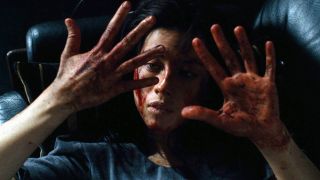
You’ll know it because of…
Sign up to the SFX Newsletter
Get sneak previews, exclusive competitions and details of special events each month!
The fact that it’s the most aggressively disturbing, brutally graphic horror film of the last few years. Probably the absolute peak of the French new-wave of extreme cinema, Martyrs’ uncompromising unpleasantness really cannot be recommended to everyone. Even the most stalwart, gleefully desensitised horror fan might may have trouble processing it, for days afterward (I did, and I’m entirely unashamed of the fact). Starting out unsettling, and unravelling in ever more nightmarish, bloody, relentlessly upsetting ways until it’s utterly devastating climax, Martyrs is a film in which you’ll always, always think you’ve experienced as bad as it can get, until it gets worse. In a way you really could not have imagined. Or wanted to.
But is it any good?
If you can handle it, then good Lord, yes. It might be one of the most emotionally troubling films of the last decade (no ‘might’ about it, actually; it is), but Martyrs is also one of the smartest. Even just on the level of pure, cinematic construction, the pacing and razor-sharp escalation of its exponentially horrific ideas are flawless, always entirely aware of the audience’s emotional state, always quietly, insidiously guiding the viewer through a labyrinth of invisible peaks and troughs, always ready to blindside them with a new, much greater nightmare just as they become comfortable with – or at least resigned to – the current one.
But beyond that, this is a film with things to say. A real, bona fide, proper horror film, that understands how to use its harrowing excesses to make points, to raise issues, and discuss. This is no mere vicious titillation. Martyrs is about something, You might not realise it until you’ve had time to process, recover, and take stock, but once you do, Martyrs is a film that will stay with you for a long time, for reasons far beyond the shaking impact of its surface horrors.
Just don’t touch the 2016 remake.
Eden Lake (2008)

You’ll know it because…
After a quiet period on the British horror scene, it turned up out of nowhere to mix the traditionally gritty, social-realist UK aesthetic with all-out horror, making quite the name for itself with the impact of that combination. Jenny and boyfriend Steve are taking a country break at the titular lake, getting away from it all with a few days quiet camping by the woodland water. Their first afternoon on the beach is hampered by a group of unruly teenagers. Steve intervenes, and things eventually dissipate, albeit acrimoniously. But as Jenny and Steve’s trip wears on, it rapidly becomes clear that the dispute is far from resolved, and that the escalation has only just begun.
But is it any good?
Yes. A constantly tense, frequently harrowing wilderness horror, Eden Lake’s real strength is in the way that its graphic intensity is couched in real, human drama driven by a strong, experienced cast. Kelly Reilly and Michael Fassbender deliver a central relationship that feels entirely real, with multiple layers of nuance bound by a genuine sense of closeness.
But just as good are the teenagers themselves. Highlighted by the consistently brilliant Jack O’Connell and Thomas Turgoose (best known for Skins and This is England, respectively), they make up a fantastic ensemble cast, fuelled and fractured by rage, personal damage, doubts and splintering humanity, making Eden Lake feels as much Lord of the Flies as Friday the 13th. Some critics have - understandably - raised concerns over Eden Lake’s possible implied commentary on class issues in the UK, particularly an inferable demonisation of the working class, but depending on how you read it, there’s actually a fair bit to chew on in all areas of the discussion.
The Human Centipede (2009)
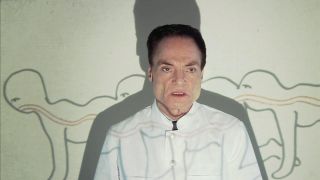
You’ll know it because…
It’s the one where a surgeon sews people’s mouths to each other’s bums. Enough said.
But is it any good?
Not at all. Entirely smug about the nastiness of its central concept, but bringing nothing of interest or meaning along with it, The Human Centipede is a petulant film that delights in nothing beyond the basic shock value of its big idea. The fatally compounding issue then, is that it’s also really boring. It scampers around expecting plaudits for being so unpleasant, but doesn’t even deliver on a gross-out level, presenting its conceit in a pointlessly polite, reserved fashion all-but guaranteed to alienate even those who came to it for simple, mindless grimness. Also, its acting and writing are often so bad that within the first five minutes you’ll be praying for its cast’s mouths to be attached to arses just to stop them talking. And yes, eventually someone does poop in someone else’s face. But by that point you’ll be so bored that you’ll just be glad that something, anything, is happening.
The Descent (2005)
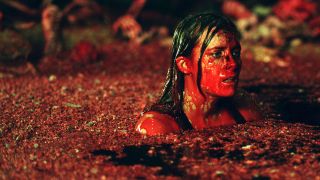
You’ll know it because…
After making a moderate impact at the cinema, The Descent has gone on to gain a much greater following via home releases and word of mouth. Following an all-female group of friends on an extreme sporting trip to explore an underground cave system, its darkness is present long before the lights go out, stark, yet affectingly portrayed emotional trauma and long-term psychological damage underpinning some of the key relationships from the very start. But then the group goes underground, and a much more physical threat presents itself.
But is it any good?
It’s fantastic. Unsettling through its emotional drama as much as its - entirely terrifying - explicit horror, The Descent is a film with a great many tools in its box, and which crucially knows how to use all of them in perfect unison. Tension, mistrust, claustrophobia, darkness, a constant fluctuation between hope and despair, and of course, The Obvious Scary Thing; The Descent is an experience of omnipresent, resonating upsets, stewing away in a cauldron as deep and dark as its cold, pitch black, subterranean pits. Just make sure to watch the original, UK theatrical edit. The American version clumsily changed the ending, resulting in a far less powerful, and really rather dumb conclusion.
A l'Interieur / Inside (2007)

You’ll know it because…
Honestly, you probably won’t. A l’Interieur, translated to ‘Inside’ in English, is part of a long tradition of pregnancy-based horror stretching from classics like Rosemary’s Baby to the recent, and also excellent, Shelley. But what sets A l’Interieur apart is that, whereas those films play with the worst fears of potential parents, and the power of maternal instinct, here there’s no flinching whatsoever. The parental angst is certainly there, but it’s also the foundation for a great deal of ever-escalating, bloody violence. What starts as a low key but horrendously tense home invasion piece blooms into spectacular brutality, leading to a split-second in which the viewer inevitably goes from, “but surely they’re not going to actually…” to “BURNITALLDOWN”.
But is it any good?
Yes, though that should be caveated by saying it’s very much part of the same New French Extremity school of horror that spawned Haute Tension and Martyrs. Which means to say it’s so unremittingly nasty that you’ll want a shower afterwards and certainly won’t want to see it a second time. What’s especially startling about A l’Interieur is that its terrible premise isn’t so outlandish, and has in fact - if you’ll pardon the image - been ripped from numerous headlines around the world in which pregnant women have been subjected to this kind of nightmare. Also you’ll never look at scissors quite the same way again. Thanks, France.
A Serbian Film (2010)

You’ll know it because…
Someone told you about it in a bar, and it sounded so absurdly unpleasant that you felt compelled to immediately read the Wikipedia synopsis, which sure enough confirms that “newborn porn” is a core plot element. But frankly, A Serbian Film’s reputation as the ne plus ultra of extreme horror is undeserved. The events in the movie - essentially: hard up semi-pro Serbian porn star gets drawn into a Hostel-style nightmare world of necrophilia and (much) worse - are infinitely more shocking when imagined than they’re shown on screen. Nonetheless, A Serbian Film managed to get itself banned in multiple countries.
But is it any good?
Not really, no. From the get go the niche A Serbian Film attempts to carve is one-upping other horror movies conceptually by delivering on the most outlandishly upsetting scenarios imaginable. But without much emotional heft behind it, aside from the really outre ideas, this is essentially a clunky tale of a bunch of (very, very) bad stuff happening to an increasingly harassed looking dude, of which there are many better examples. [Spoiler Warning] Interestingly, the ending closely mirrors the climax of the much better Kill List, though both were in production around the same time and there’s no suggestion of copying.
Livide / Livid (2011)

You’ll know it because…
It’s the weirder, creepier follow-up to L’Interieur from directors Julien Maury and Alexandre Bustillo. As much fairy tale as horror film – it’s very much comparable to the work of Guillermo Del Toro, with a dash of Silent Hill on the games side – it follows Lucie, a young, in-home nurse-in-training, who discovers the possibility of hidden treasure in the home of one of her elderly, now comatose patients. Breaking back into the house at night with a couple of friends, she discovers much more, all of it very unsettling indeed. You know, corpse-dolls, that sort of thing.
But is it any good?
Yes. Despite the blunt, shocking, bloody horror on show, Livide is a gorgeously crafted film, blending tonal elements from the slasher film, supernatural horror, and a great deal of dreamlike, whimsical, folk-tale texture. Spiralling from gritty, real-world horror to something altogether more fantastical, the ultimate changes in its conceit make for a strong end-to-end contrast, but are almost always woven together with care and subtlety. An affecting and rather beautiful little film, and entirely under-watched.
Haute Tension / Switchblade Romance (2003)
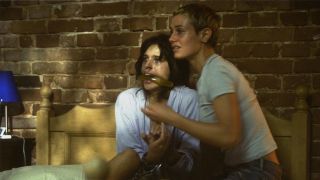
You’ll know it because…
Actually, you might not. Haute Tension is a bit obscure, garnering only cultish plaudits on the dedicated horror scene at its release, the buzz not spreading anything like as far as that for some of the more overtly controversy-baiting – and worse – films on this list. A blunt, giddy, punk-ass little slasher film set in rural France, Haute Tension tells the story of Marie and Alex, two college friends who head to Alex’s parents’ house in the country for a weekend study break. A serial killer arrives, and hilarity ensues. Hilarity, and a whole lot of spewing arteries.
But is it any good?
Yes, with a caveat. Do not go into Haute Tension expecting cerebral slaughter or anything in the way of deeply resonate commentary amid the fountains of gushing gore. This is a big, dumb slasher film with no aspirations to be anything else. But, with that focus, it dives into its mission with furious glee. And possibly the best use of a staircase and wardrobe you’ve seen in a horror film. Just make sure to watch the uncut, subtitled, 91-minute DVD and Blu-ray cut rather than the edited, dubbed theatrical one. Because there is no point in a film like this if you’re going to cut down the gore. And dubbing is for jerks.
The Hills Have Eyes (2006)
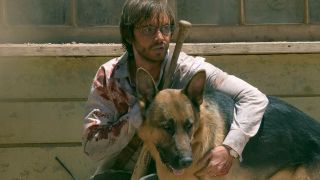
You’ll know it because…
It’s the savage remake of the second film directed by A Nightmare on Elm Street creator Wes Craven. Directed by Alexandre Aja, the man behind Haute Tension, making his first English-language film, it’s the bloody, uncompromisingly violent story of a family vacation gone horribly wrong, by way of a breakdown in cannibal mutant-man territory. A lot of people die in a lot of horrible, often protracted, ways.
But is it any good?
Surprisingly, it’s pretty good. It has no right to be, of course, being a modern remake of an important part of the horror canon, but against all odds – and probably because the production snagged Aja straight off the back of Haute Tension – it is a worthy film in its own right.
You’ll need a high tolerance to cope with its sustained ferocity – there were well-documented walk-outs at multiplex screenings when it was first released – and if sexual violence is an (understandable) button for you, then certain explicit and implied sequences might be a reason to steer clear. But if you can deal with the above, The Hills Have Eyes is a sharply directed, and very well-paced rollercoaster of jarring horror, with a smart instinct for slow-burn character development before everything goes to hell. That it even manages to raise a couple of – admittedly light – morality questions amid the unyielding devastation is an unexpected bonus.
Kill List (2011)

You’ll know it because…
It was mentioned a bit further up this list. Also, it made a minor slash on the horror scene a few years ago, and was the film that first put a (fairly cultish) spotlight on director Ben Wheatley, who has since gone on to make serial killer black comedy Sightseers, the starkly surreal A Field in England, some episodes of Doctor Who, and the excellent 2015 adaptation of JG Ballard’s High Rise. It’s the story of an ex-soldier turned hitman trying to maintain both his marriage and his mental health amid the pressure of his job. But then an enigmatic new client procures his services, and things begin to tumble into far more troubling territory.
But is it any good?
It’s brilliant. An immaculately managed, fatalistic spiral of a film, Kill List is one of the best constructed horror films of the last decade. Its descent into darkness is as insidious as it is claustrophobic, as starkly unsettling as it is matter-of-fact. Intense flashes of bloody violence mingle with deeply disturbing, true-life horrors, just as the entire film floats along on a flat sea of downbeat, realist drama.
But something else is going on in Kill List. An invisible, but ever tangible, something that worms its way through the story, surfacing occasionally to almost reveal itself, before sinking again to weave its unnamed putrescence further. Eventually things will come to a head. Things will remain relatively oblique, but you’ll understand. Things will be horrible too. You might well swear off watching Kill List again, once the full weight and depth of its story reveal themselves. But then you'll watch it again. Because you’ll have to. Because you’ll need to understand more.
Most Popular




